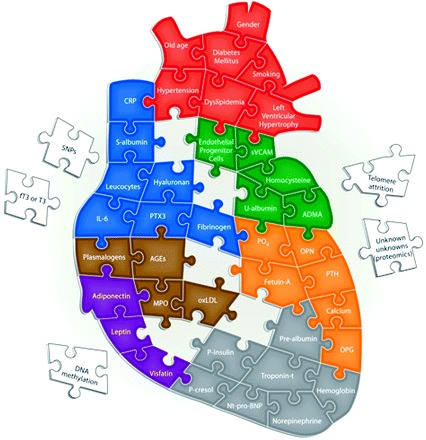Figure 2.

The complicated puzzle of uremic CVD. Red puzzle pieces depict traditional (i.e., Framingham) risk factors thought to contribute to an excessive cardiovascular risk in CKD. The fact that many pieces in the puzzle are false (i.e., some pieces are risk markers and not etiological cardiovascular risk factors) renders the possibility to solve it more difficult. Blue puzzle pieces depict some inflammatory biomarkers that have been demonstrated to be associated with poor outcome in CKD. Green puzzle pieces depict some risk markers associated with endothelial dysfunction. Orange puzzle pieces depict risk markers associated with vascular ossification. Brown puzzle pieces depict surrogate markers of oxidative stress that have been associated with cardiovascular outcome in CKD. Purple puzzle pieces depict the emerging role of adipokines in uremic CVD. Gray puzzle pieces depict other risk markers associated with CVD in uremia, such as markers associated with volume overload, protein-energy wasting, and sympathetic overactivation. Finally, white puzzle pieces displayed outside the heart depict some emerging risk markers that may be associated with uremic CVD. CVD, cardiovascular disease; CKD, chronic kidney disease; CRP, C-reactive protein; sVCAM, soluble vascular cell adhesion molecule; SNP, single nucleotide polymorphism; T3, triiodothyronine; PTX3, pentraxin-3; ADMA, asymmetric dimethylarginine; AGEs, advanced glycation end products; OPN, osteopontin; PTH, parathyroid hormone; MPO, myeloperoxidase; oxLDL, oxidized LDL; OPG, osteoprotegerin; NT-pro-BNP, N-terminal pro-brain natriuretic peptide.
